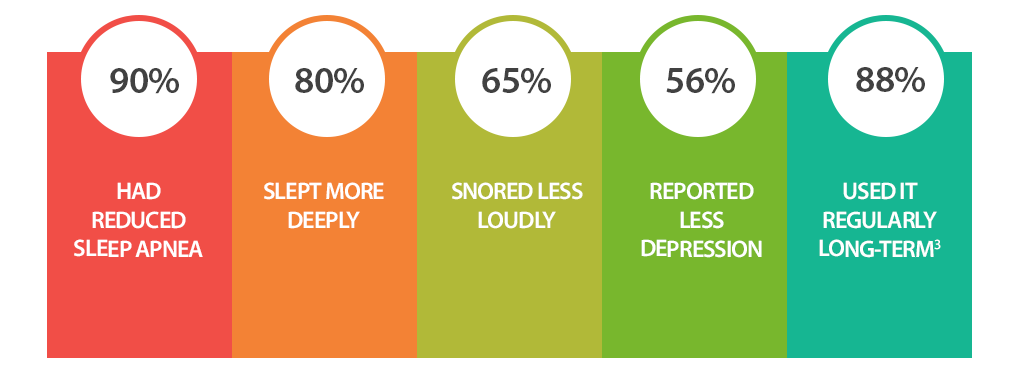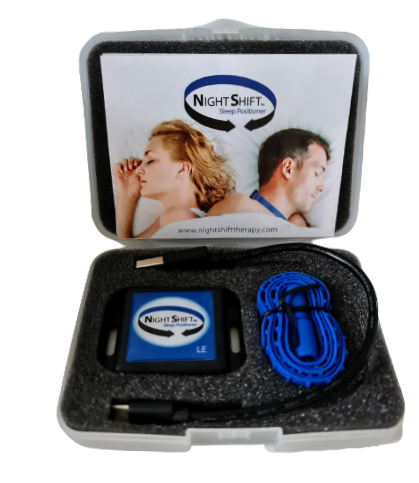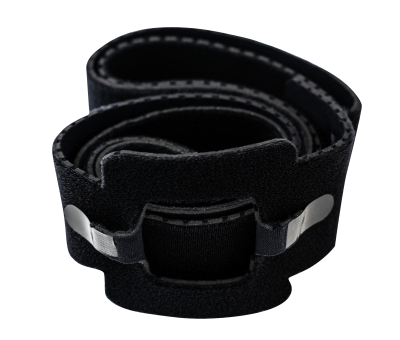We're really pleased to announce the addition of the Night Shift Positional Therapy device which has been around for a long time and was validated back in 2014 by the FDA for treating positional sleep apnoea and snoring. In fact the August 2018 NICE Guidelines for Obstructive Sleep Apnoea also recommended Positional Modifiers for mild to moderate positional sleep apnoea, so hopefully in the near future sleep clinics will also be able to prescribe devices to patients such as the Night Shift.
What is Positional Obstructive Sleep Apnoea (POSA)?
This is when the results of a sleep study for obstructive sleep apnoea show that the majority of apnoeas and/or hypopnoeas occur when sleeping in the supine (back) position. It is due to gravity causing the tongue to fall back which blocks the airways, and other factors such as gravity changing the shape of the airway causing the soft palate to collapse, the tonsils to crowd the airway and other factors like fat in the neck or receding jaw etc crowding the airway.
If Positional Obstructive Sleep Apnoea (POSA) is proven on a sleep study there is a good chance that sleeping on the side or even on the front (but beware that prone sleeping long-term can cause neck and back pain) can cure the sleep apnoea, but even if it doesn't fully cure it good results can be achieved in lowering the severity and can it can even lead to lower CPAP pressures. As under our 'important note' on the page though, please always request a repeat sleep apnoea or take a private sleep study before making a decision to come off prescribed CPAP or other therapy for the sleep apnoea.
What is Positional Snoring?
This is exactly the same as for Positional Obstructive Sleep Apnoea (POSA) in that most snoring takes place for the same reasons when laid in the supine position. The difference is that not all snorers do have sleep apnoea (although due to the health risks of untreated sleep apnoea it is definitely always worth having a sleep study to rule out obstructive sleep apnoea (OSA), either at a sleep clinic or even a private sleep study).
Even when snoring isn't causing OSA it still needs addressing, as snoring, apart from causing unrestful and interrupted sleep to the snorer, can cause health issues such as thickening of the artery walls (Carotid Atherosclerosis) - as well as disturbing the sleep of the bed partner! Therefore, if snoring does happen mostly when sleeping on the back (supine) position, this is one of the first things to try to avoid, even though other factors may help as well in combination like Nasal Strips, Oral Strips, (safe) Mouth Strips or other solutions like Nasal Dilators, Saline or prescribed Nasal Sprays etc.
What is a Positional Therapy Device?
There are a range of devices for keeping the snorer or the diagnosed sleep apnoea patient off the back, ranging from sewing a tennis ball into a t-shirt through to superior devices like this Night Shift. The difference and price of the Night Shift is that as well as training you to sleep off your back by the gentle vibrations (certainly less disruptive than the better partner giving a sharp elbow nudge) to encourage you to change sleep positions, the user of the NightBalance can keep of track of how they're doing via the apps or computer software (explained later on this page) to compare how you feel during the day and how well you slept by seeing the evidence on the reports:-

Hope2Sleep Charity's Observations:-
The Night Shift has evolved over the years so that there are now two options of using it, either with the original neck strap or the addition of the optional chest belt, to suit individual preference:-

(Please note the Chest Belt is not supplied with the Night Shift and is an optional extra. If choosing to use the Night Shift with the Chest Belt the device will need setting up in the software before use for accurate data).
The reason we believe the Night Shift to be a better option than cheaper devices or self-help positional treatments like sewing a tennis ball into the back of a t-shirt for sleeping, is that it's so important to check that you are actually managing to sleep off your back and the free apps and computer software will give evidence of this, as it's not possible to know how you're sleeping without someone watching you all night.
Advanced Brain Monitoring say:-
The Night Shift is a patented, clinically-proven therapy for patients with positional obstructive sleep apnoea (POSA) that can be worn around the neck or chest.
After allowing the user time to fall asleep in any position, it begins to gently vibrate when the user attempts to back-sleep. The vibration then gradually increases in intensity until the user changes position.
Night Shift is an intelligent, interactive monitor that also allows patients and clinicians to track sleep quality and therapeutic effectiveness via the Night Shift application on iOS & Android devices or a web-based portal.
(Click on image below to download the therapy applications from the manufacturer's website)
Example of an Efficacy Report (and other compliancy reports are available)
Tracks how frequently and how quickly you respond to vibrations, positional feedback and assessing both sleep quality and snoring
Night Shift can also be combined with a wrist oximeter to screen for POSA and/or assess the benefits of combination therapy.
Clinical Evidence
Our research has shown that up to 70% of patients diagnosed with obstructive sleep apnoea are substantially more severe when back-sleeping 1. This results from the tongue falling back and blocking the airway and gravity contributing to increased collapsibility of the airway 1. We also found that 20% of sleep apnoea patients would have little-to-no breathing problems if back-sleeping were avoided 2.
In our studies of Night Shift positional therapy the following results were found: 1,3

SOME COMMON QUESTIONS
How do I know if I'm a good candidate for the Night Shift?
If you were previously diagnosed with Sleep Apnoea you are a good candidate for Night Shift if:-
- Your sleep study report shows your “supine” sleep apnoea severity is two times your severity when you don’t sleep on your back (i.e., supine apnoea hypopnea index (AHI) is twice as high as your non-supine AHI)
- Your non-supine AHI is less than 20 events per hour
Which health conditions limit me from using the Night Shift?
We recommend that Night Shift is not used on patients who:
-
Suffer from tics or tremors of the head
-
Suffer from cardiac arrhythmia corrected by an artificial pace-maker
-
Have neck less than 12 inches (30 cm) or greater than 22 inches (56 cm) OR have a chest larger than 59 inches (150 cm)
-
Are currently suffering from neck, shoulder, or back pain
-
Have an open cut or wound near where the Night Shift is worn (you may need to temporarily discontinue use)
What if I can't fall asleep unless I'm on my back?
Night Shift delays the start of therapy for 15 minutes after the device is turned on in order to give you time to fall asleep on your back. If you need more time, you can use the Report Portal to increase the delay to 30 minutes.
Won't the delivery of vibro-tactile positional therapy interrupt my sleep?
If you have sleep apnoea, you may experience fewer interruptions than you do now. In the previous study of Night Shift for prescription use, both brief arousals, as well as awakenings, were significantly reduced because patients slept more deeply. Users recalled position avoidance therapy on average twice per night, yet they attempted to sleep supine on average seven times per night.
How do I choose between the neck strap or chest belt?
The chest belt is simply an alternative for those who prefer not to receive therapy on the neck. The chest belt must be worn more tightly than the neck strap to stay in place during sleep, and sleep efficiency and awakenings are not reported.
(If the chest belt is preferred, you must adjust the settings in the Night Shift software before use).
The Chest Belt is an additional optional accessory and available on a separate listing
(There are lots more questions and answers on the manufacturer's website:-
Included in the Box:-

Optional Extra:-

Specification:-
Dimensions - 5.6cm x 3.8cm x 1.3cm
Weight - 45.4g (1.6oz)
Rechargeable Battery - 200mAh lithium polymer
Software Requirements:-
Portal Software
- Operating System: Microsoft Windows 8 and 10, Mac OS
- USB 2.0 Port: 1
- USB read/write access
- PDF Viewer
App for Phone/Tablet
- Operating System: iOS 14+ or Android 10+
- Bluetooth 4.2+
- Internet Connection
Warranty:-
2 year warranty covering workmanship problems related to the electronics during its 3-year service life.
1 year warranty on battery and haptic motors.
6 months warranty on replaceable neck strap and optional chest belt.
Warranty does not cover damage attributed to improper use by the customer.
Night Shift is a medical device that is not waterproof, pet-proof, or mistake-proof.
The warranty will be void if an attempt is made to open the enclosure or change the battery.
Click here to download optional Chest Belt Set Up Instructions
Important Notes
If you have been diagnosed with sleep apnoea and believe the Night Shift or other positional remedy has been successful in keeping you off your back during sleep, please insist on a repeat sleep study from your clinic or even privately like our own sleep study service to check that successfully changing your sleep position has cured the sleep apnoea before coming off your CPAP therapy or other treatment.
You must NOT use the Night Shift in the following circumstances:-
-
Suffer from tics or tremors of the head
-
Suffer from cardiac arrhythmia corrected by an artificial pace-maker
-
Have neck less than 12 inches (30 cm) or greater than 22 inches (56 cm) for use with the neck strap
-
Have a chest larger than 59 inches (150 cm) for use with the chest belt
-
Are currently suffering from neck, shoulder, or back pain
-
Have an open cut or would near where the Night Shift is worn (you may need to temporarily discontinue use)